Neroli Henderson is an Australian textile artist living in St Kilda, Melbourne. Often described as an Artivist she creates feminist, political and other artwork focussing on the human condition and fighting for social change.
Neroli’s artwork is in private and commercial collections worldwide, she regularly exhibits internationally and has won awards at home and abroad.
In this interview, Neroli tells us how an accident at home left her unable to move much for 7 years until her mum dragged her to a quilting exhibition and her love of stitch began. We discover how she developed her unique style and why she is compelled to use it to highlight injustices in the world.
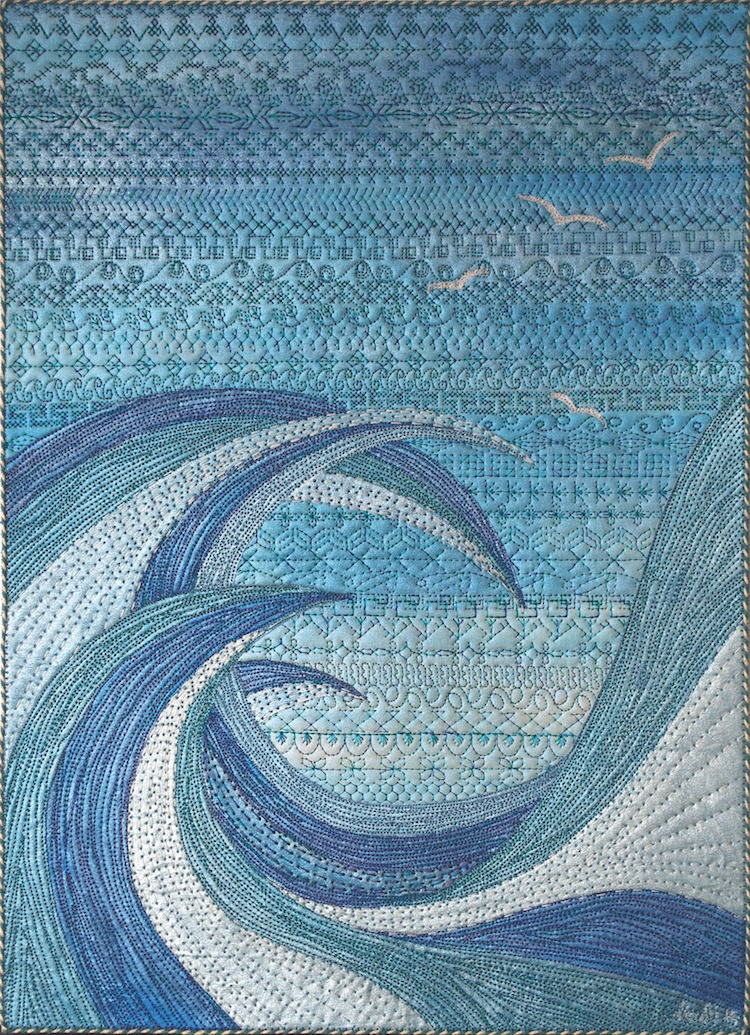
Hook, line and sinker
TextileArtist.org: What initially attracted you to textiles as a medium?
Neroli Henderson: I’d never contemplated using textiles until my Mum dragged me along to a quilting convention with four days of classes that covered free-machine stitch and fabric collage.
I didn’t even know that you could draw with the sewing machine and once I realised I could create texture at exactly the same time as line I was hooked.
There are also so many great materials and special effects that can be achieved with multimedia, from metal foil and Angelina fibres through to combining metallic fabric paint, photography and reflective or other speciality threads.
And, more specifically, how was your imagination captured by stitch?
Being able to create line and texture at exactly the same time is wonderful!
Threads come in so many weights and types. I’ve used threads that only show up when photographed with a flash, light-reflective thread, threads that change colour under sunlight, clear thread, thick hand stitch only weight thread in the bobbin or even ribbon and ultrafine 100wt threads. There’s metallic and variegated, glow in the dark and more!
Overall, there are just more options than there is with paint, even with the myriad of mediums now available. And all of that is without even considering the huge amount of substrates you can stitch into.
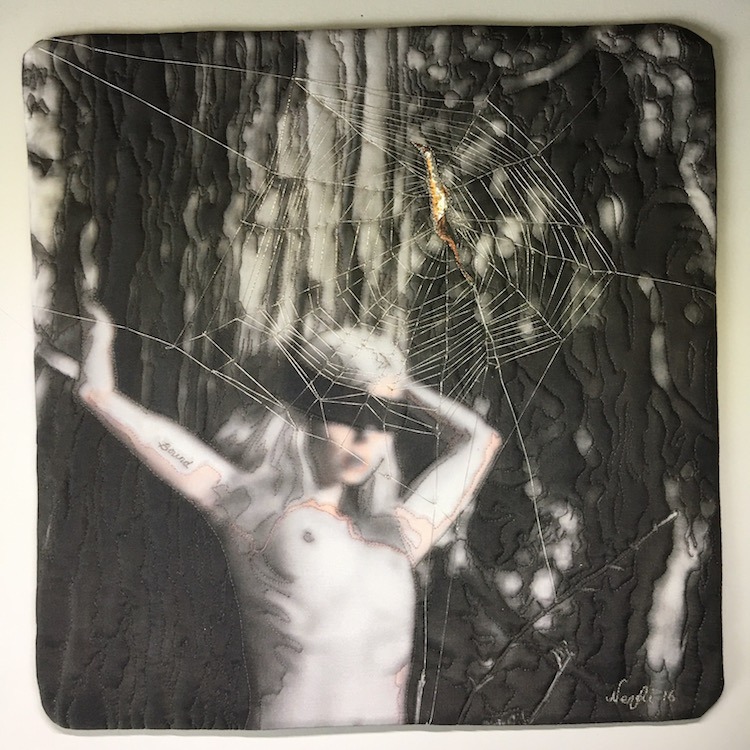
About the piece: We often stay when perhaps we should leave, be this in bad relationships or in other aspects of life. We feel bound and for some reason fail to make an effort to escape.
The effects of this on our personalities and friendships can be felt for years, causing another hurdle to surmount.
What or who were your early influences and how has your upbringing influenced your work?
I learned so much about quilting at that first AQC; Australasian Quilting Convention. It was four days of intense mind-blowing!
I followed that up with asking about 10,000 questions online and everyone was so helpful. I joined a couple of yahoo groups which have now largely been replaced by FB groups and still to this day ask questions when I need to. Nowadays I get to answer a few too though.
My life has had a huge impact on the work I produce. My upbringing was a very strict one, my family is very conservative and religious and I grew up in a tiny country town in rural Victoria.
I was always the black sheep and drove everyone mad questioning why I had to do things the way everyone else did and why people believed what they believed. I didn’t understand a religion that preached loved but condemned people for their sexual orientation or suggested they act differently due to their gender.
It’s definitely one of the reasons I use my work to campaign for things I now do. I think we create our best artwork when the meaning behind it is something deeply personal to ourselves.
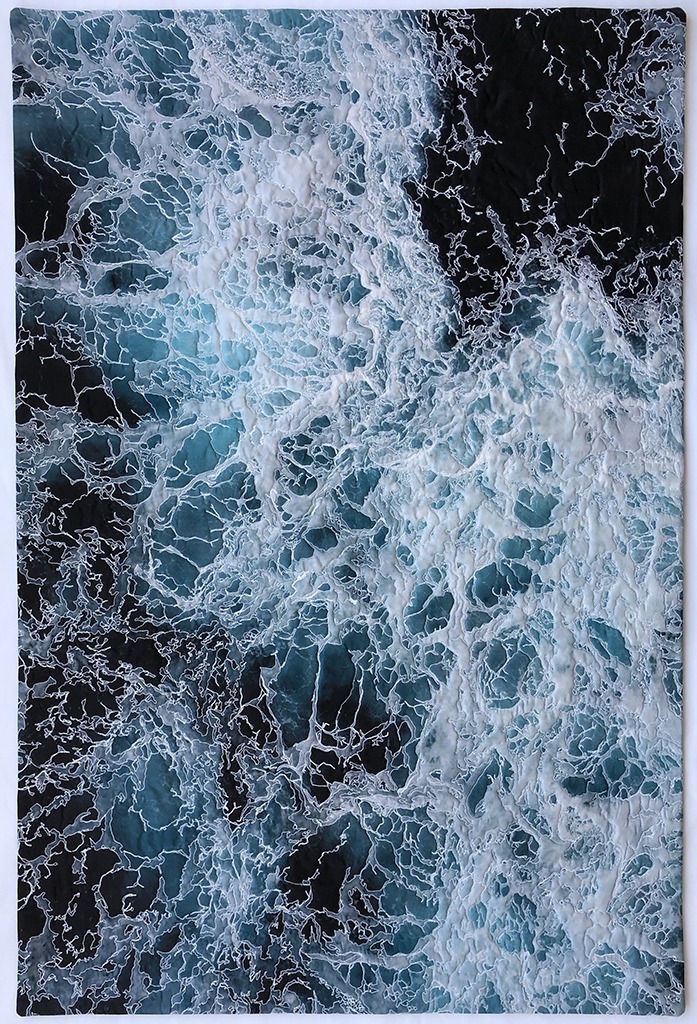
About the piece: A departure from my normal work, while still depicting turmoil in a semi-abstract fashion.
Falling into a world of quilts
What was your route to becoming an artist?
I always wanted to be a fine artist, however, I also wanted to make decent money and I mistakenly believed it was a pipe dream to think you could do both. I studied graphic design at university instead and went on to be the Art Director for Shell Australia by age 23.
However, at 25 I fell down my stairs at home while rushing to get the phone and, even though I landed sitting up on the landing and didn’t even hit my back, I managed to crush one of my upper back vertebrae.
This effectively ended my graphic design career though it took me a few years to realise it. I spent much of the next 7 years laying down, working when I could and being in far too much pain.
It wasn’t until about 4 years after my accident after I’d developed a whole lot of secondary illness due to the pain (fibromyalgia, narcolepsy, periodic limb movement) that I managed to find a doctor who was willing to prescribe pain relief strong enough that I could start moving again.
Over the next 6 months I got my walking up to about 30 minutes and over the next few years, my sitting and abilities have increased though I’m not ever going to be ‘normal’ in that regards.
I was feeling quite sorry for myself when my mum suggested I come to the quilting convention with her. I had stopped doing almost all work and was purely existing.
Quilting came as a bit of a lifeline really. You move your upper body so much more with free-motion and I find my back can tolerate it far better than being on the computer but there’s also a lot more getting up and down and movement in general than there is with something static like graphic design.
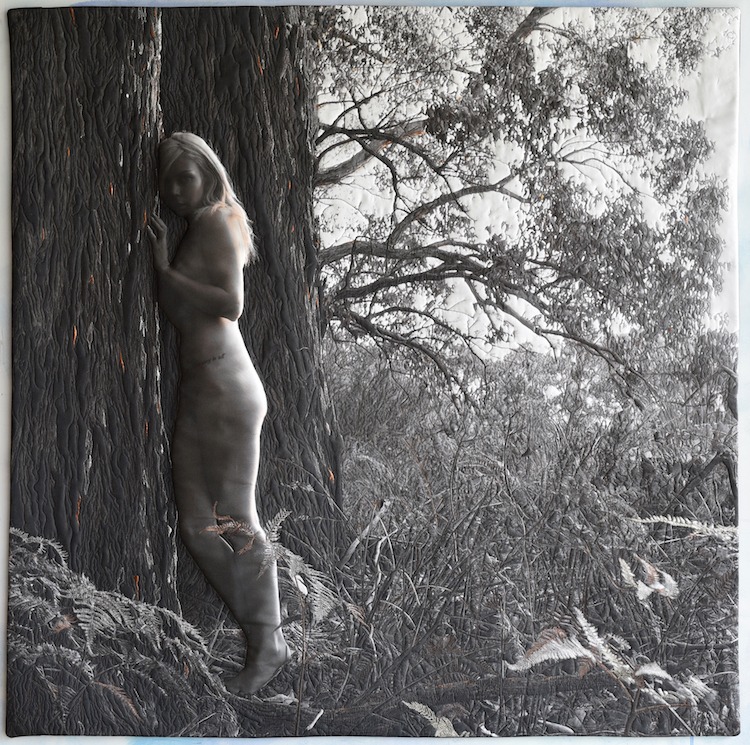
Tell us a bit about your chosen techniques.
The first thing I do in a work is choose what I want it to say. Only then do I choose how I want it to look and sketch up designs. Technique is one of the last things I look at and I’ll often use different techniques for different parts of work.
When I started using textiles I was working with every weird and wonderful technique and medium I could find and I have paired that very much back, for the most part, these days. I cringe when I look at some of my earlier works, minimalism is certainly not present! Especially when I look through the eyes of a designer, there is just so much going on!
My favourite techniques these days are either painting or using one of my photographs for a quilt top and then embellishing with a whole lot of stitch and often metal foil. I also use machine trapunto a lot as well, though I’ve noticed that even that is decreasing.
How do you use these techniques in conjunction with quilting?
I access each piece on an individual basis. With my latest Soul Scars series, I use 100wt ultra fine thread with a 70wt needle on very fine silk so that I’m not crossing out the photograph I’ve had printed onto fabric. I’m using the quilting to add texture, drawn in backgrounds and text and using jump stitches, or long stitches, in some of the works.
In my more complex, layered pieces I often stitch each piece separately before putting together as a whole and adding quilting. This allows me to choose what amount of loft I want each piece to have on top of how much stitching or what type.
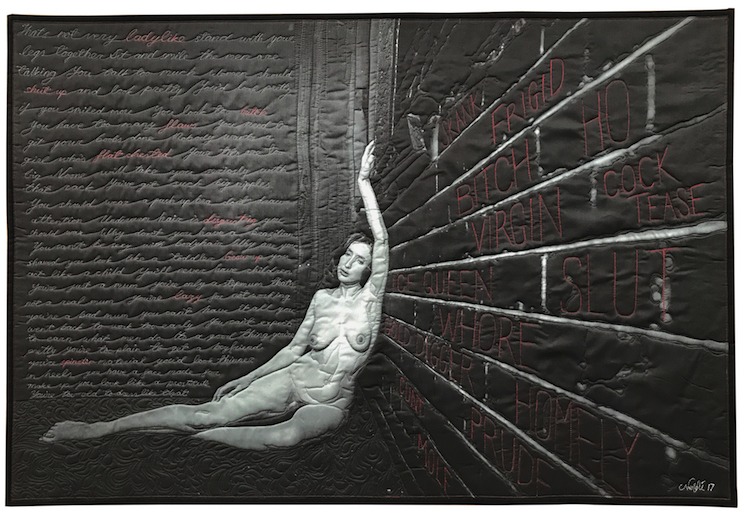
About the piece: Throughout their lives, women often encounter phrases aimed at their gender. Seemingly innocuous or cruel and vulgar, each leaves their mark, tainting their ego, personality and sense of self.
How many of these have you heard? How many have been said to you? How many have you said to someone, even in jest? Are they now scribed in indelible ink on someone else’s soul?
These “women’s words” are often used by women, towards women, self-perpetuating the inherent gender disparity in our society.
The words on the left-hand side of the quilt are:
That’s not very ladylike. Stand with your legs together. Sit and smile the men are talking. You talk too much. Women should shut up and look pretty. You’d look pretty if you smiled more. You look too butch. You have too many flaws. You need to get your boobs done. Nobody wants a girl who is flat chested. Your tits are too big. No one will take you seriously with that rack. You’ve got such big nipples. You should wear a push up bra. Don’t draw attention. Underarm hair is disgusting. You should wax. Why don’t you have a Brazilian. You won’t be sexy with body hair. You look like a toddler. Grow up you act like a child. You’ll never have children. You’re just a mum. You’re only a step mum, that’s not a real mum. You’re lazy for not working. You’re a bad mum. You can’t have it all. You went back to work too early. You can’t expect to earn what men do. It’s a good thing you’re pretty. You’re too plain to get a boyfriend. You’re spinster material. You’d look thinner in heels. You have a face perfect for make up. You look like a prostitute. You’re too old to wear that.
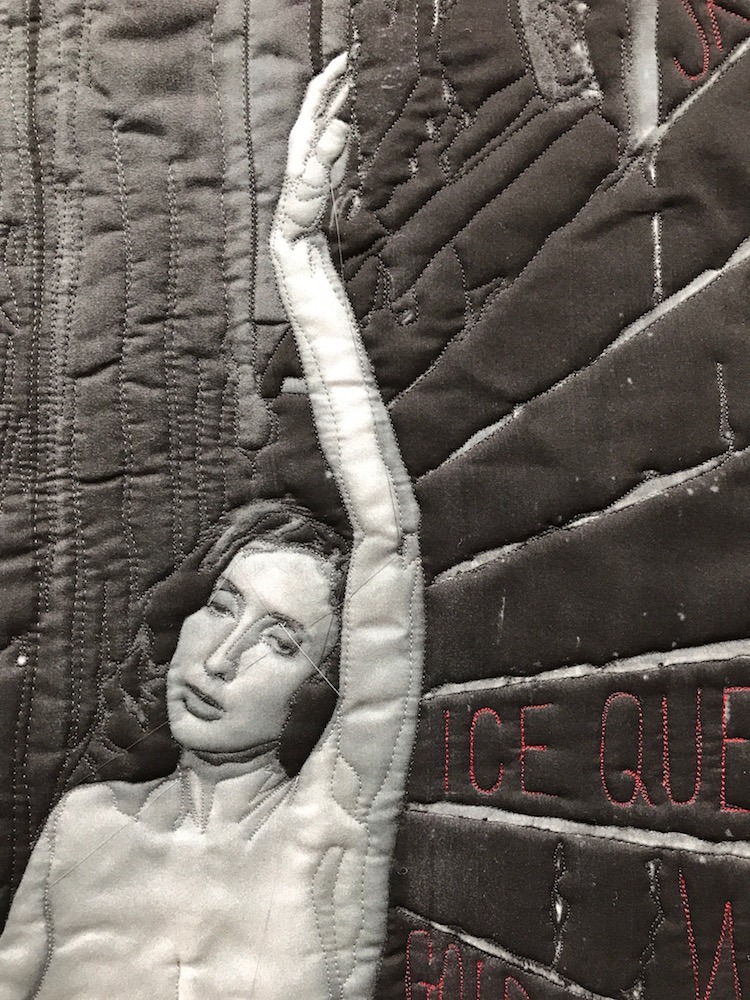
Positive feedback
How would you describe your work and where do you think it fits within the sphere of contemporary art?
I noticed that on my social media accounts and in sharing my work people were describing me as an ‘artivist’ and this label has grown on me and I’ve recently adopted it myself.
To be honest I’m not sure I’ve found my ‘home’ yet as I’d really love to get gallery representation but I have had great success with juried exhibitions and selling both through these and via my Facebook art page. I’m getting to read comments about how my work has positively affected those who have viewed it and that matters to me far more than anything else.
I do find trying to explain my work to a conventional art audience difficult, as people sometimes can’t get their mind around the fact it’s stitched and made from fibre.
I find the opposite though occasionally when talking to quilters as they don’t always understand how my work is still a quilt and it’s often too ‘out there’ for many quilt shows.
One fine art textiles exhibition in Australia classed my work as showing ‘graphic nudity’ because there was a nipple on display and wouldn’t show it.
That has not been the norm I’m happy to say though and I’ve generally had fantastic support from quilt guilds and the quilting community at large.
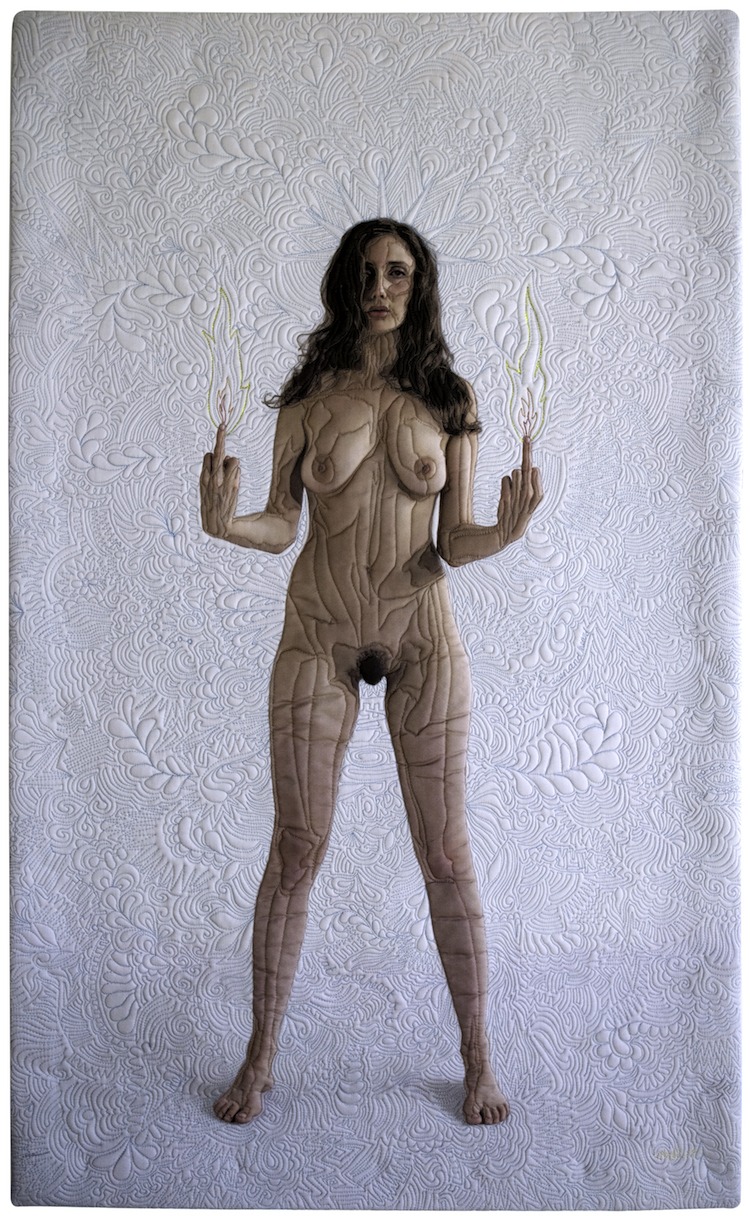
About the piece: It’s society’s own perceptions of sexuality and nakedness that skew the concept of what amount of skin is OK. How can we move forward towards true equality when we elect a man into the highest office in the world who has openly spoken about objectifying and mistreating women? It sends a message to males everywhere that behaviour of this sort is acceptable.
I for one am sick to death of hearing how women taunt men into sexual assault through how they dress or what they do when the onus should be on men behaving better.
Various words are stitched into the background of this piece including: ‘Nice Girls Don’t’, ‘Eat Your Words’, ‘Trust Me’ and ‘Think’.
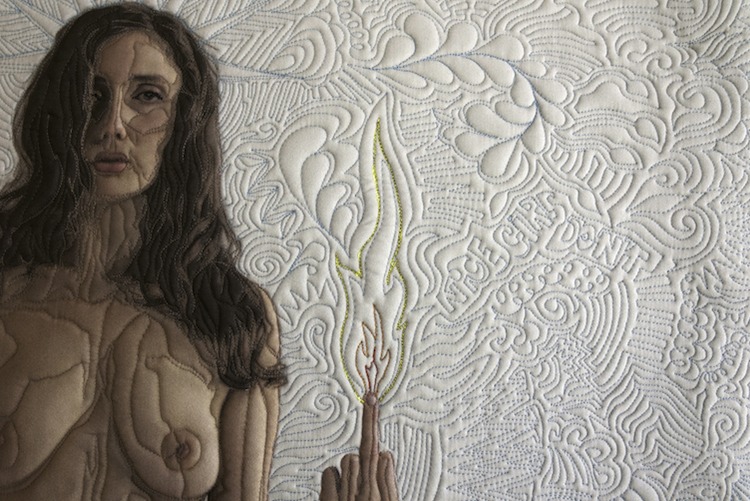
Do you use a sketchbook? If not, what preparatory work do you do?
I have a few sketchbooks but I don’t keep a beautiful one with works in order or daily sketches. I wish I did but when I open my sketchbook with the intent of drawing I find I tend to do wishy-washy faces or flowers much the same as I drew in high school.
I have a number of ‘go-to’ images that I know I can draw and lack inspiration to pick up a pencil and draw something original unless I have an idea, which almost never happens if I’ve just opened up a sketchbook to draw because I know I should.
I tend to work to themes or statements. I decide what I want to say and then scrawl all the words and sentences that come to mind with theme in mind. I’ll do some sketches and then take them to the computer and refine in Adobe Illustrator.
For my photographic works sometimes I’ll do a simple line drawing of the pose and then take the photo and then add background ideas and text to that image directly, working on a printout.
What environment do you like to work in?
I need everything to be organised and neat. This is part from necessity of space, I’ve only just gotten a decent size studio, and physical limitation, I can’t drag out tubs of things or move heavy things from on top of other things to access materials, and partly as it removes clutter so I can focus on what I want to say.
My new studio is about 80% done but still needs a proper design wall, some art and a purpose built sewing desk.
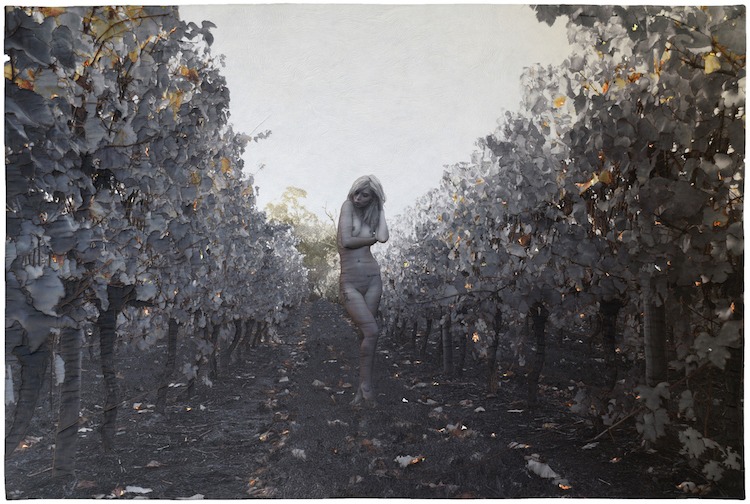
Questioning gender disparity
What currently inspires you?
The constant fight I have with my body to make it allow me to do what I want and the constraints I have due to my disability is definitely up there. As is the gender disparity I see and the various ways I see bigotry around me.
I’ve recently been more open about a sexual assault I experienced as a kid given the timeliness of the #metoo and #timesup movements felt more empowered to showcase this in a quilt too.
I didn’t notice sexism as much when I was younger and I’m not sure if this was due to naivety or if it was because when I was young and thin, much of the sexism I encountered was masked with charm and flirtation.
Now I’m in my 40’s and married it seems different. I think though perhaps in this day and age we are less willing to put up with it which is why seeing it emanating from leading politicians and the like makes it all the more gasp-worthy.
I had thought women were more equal than they actually are. The more I have read stats on gender disparity the more I’ve realised what a huge issue it is.
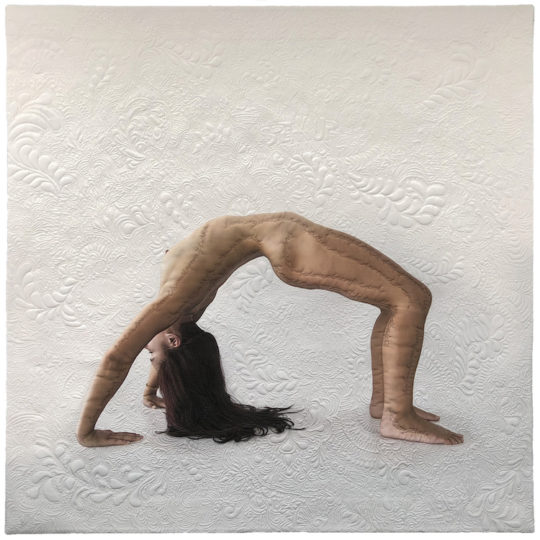
About the piece: Fear of, or caused by sexual assault causes restrictions and confinements in lifestyle and thought. These borders are internalized, held within the model, stitched in text.
The #MeToo and #TimesUp movements are exciting bridges, for the first time ever women are being heard and believed. The onus is starting to be on men to change, and not on women to curtail their lifestyle, to dress conservatively, to not provoke.
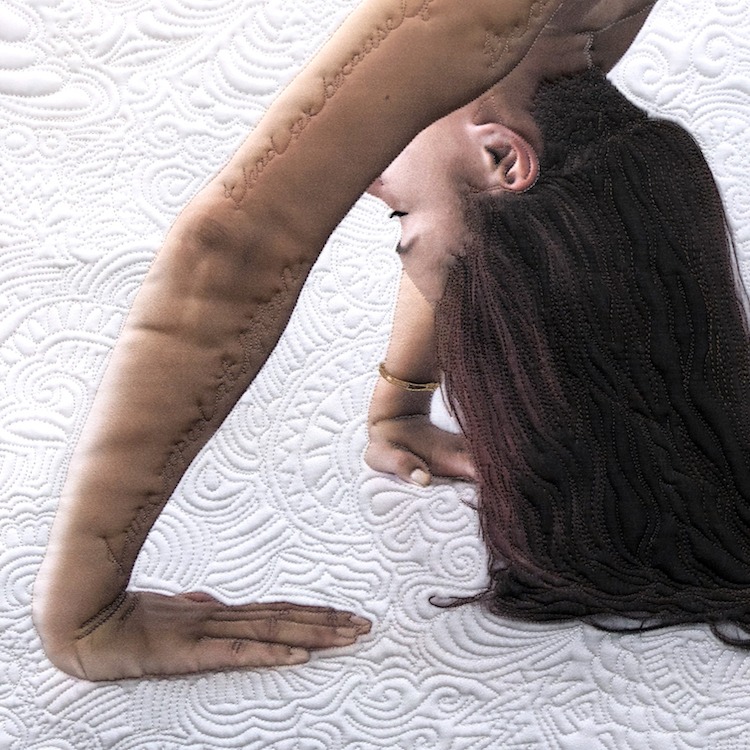
Stitched into the background are words of empowerment and hope.
This quilt can be hung either way up. The model in bridge pose or flying through the sky, free.
The words inside the model’s body include:
I was raped when I was fifteen, I had sex because I feared he would rape me if I didn’t, I wish I was braver, I wear my past like a scar that I’m not sure how much to cover, I never feel completely safe, I’m careful not to be too opinionated, I’m careful to never go out by myself alone at night, I’m afraid to be home alone after dark, I’m careful not to dress provocatively, I’m taking it back.
Within the background quilting are the words:
Nevertheless she persisted, me too, time’s up, raise your voice, rise above, equality, speak up, teach men not to rape, understanding, resist.
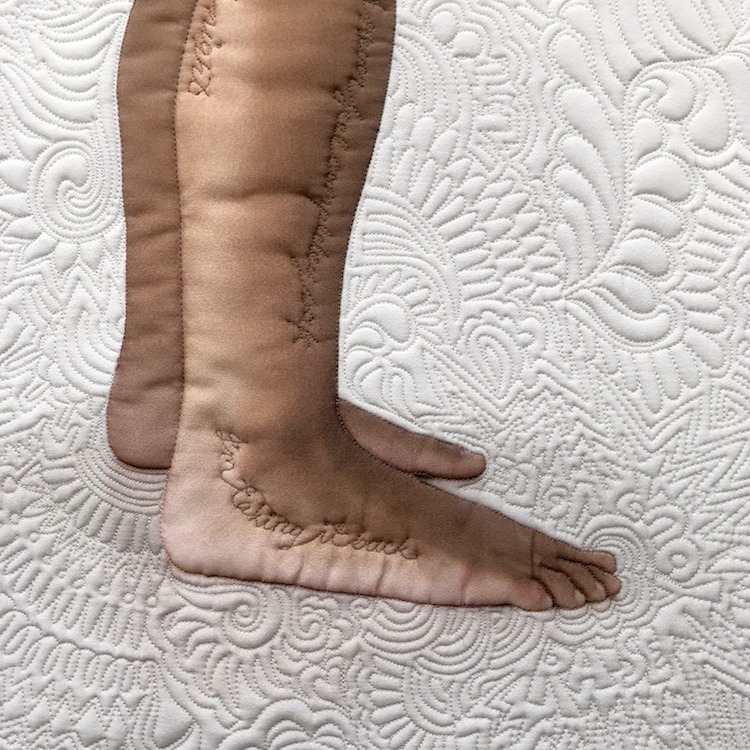
Emotional artworks
Who have been your major influences and why?
I think my work is very personal and as such the content hasn’t really been influenced by any one artist.
The emotive artworks of expressionists have played a part in my realising that emotion plays a more important role for me personally than any other element in an artwork though.
De Kooning’s ‘Women’ series is one I remember seeing at Uni and the intensity of those have stuck with me.
Tell us about a piece of your work that holds particularly fond memories and why?
To be honest much of my work holds less than fond memories as while they are cathartic to make they are usually coming from a fairly melancholy place. I like to try and turn that feeling into a work of beauty. I have plenty of favourite artworks that I love but the creation isn’t necessarily something I look at fondly.
I do love my ‘Coco, The Quilt’ as it features my last dog, a Bichon Frise that came to live with me at age 7. She was my little anchor when I was really ill and got to live with me until age 18. The quilt is quite funny and the text tells of her love of going to stand in the park for 20 minutes and then coming inside to pee on the carpet.
It’s still bittersweet though as I began it when she was already 15 and I knew it would be a commemorative work. It’s been a really successful work for me though, it’s appeared in quite a few magazines and won awards including Judges Choice and Packer’s choice as Australian shows and then an Honorary Nomination at the World Quilt Competition in the USA.
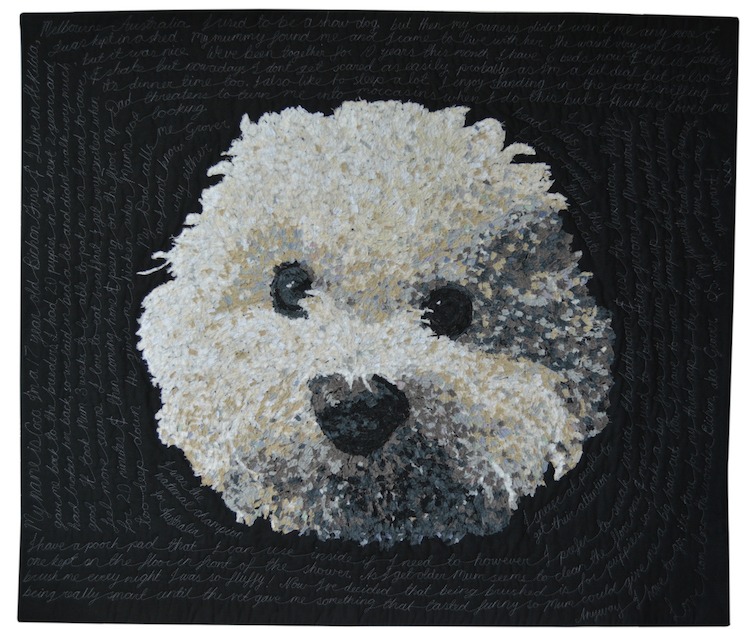
About the piece: My own ‘Confetti’ technique with the face image made from thousands of pieces of fabric with no overlay fabric or tulle. Trapunto, free machine stitched text and intensive quilting.
How has your work developed since you began and how do you see it evolving in the future?
I’ve changed so much, my textile-based work has gone from experimental through to restrained and all my pieces now work to my art statement which is to create pieces based on the human condition that explore our fragility and tenacity.
I’ve recently evolved my work to a more personal style that is part story-teller and part activist. It means each piece leaves me a little raw for a while after I make it but the reaction I’m getting has been great
Text has become a bigger and bigger part of my work, as has photography.
Art is personal taste
What advice would you give to an aspiring textile artist?
Fake it until you make it. It works. The biggest drawback I see for any new artist, or even most new business people, is their confidence. This seems to be especially true for women. We are used to apologizing or explaining our actions and putting others first.
Believe you can and you will, or if you don’t you’ll give it a damn good shot and work out what to do differently next time.
The other piece of advice I’d give is that art is personal taste. No matter how wonderful, emotive or technically perfect your work is there will always be people who hate it. Pay no attention. All you need is one person who loves it enough to put it in their home and all of the others don’t matter.
What piece of equipment or tool could you not live without?
My [easyazon_link identifier=”B0037IPE0S” locale=”UK” tag=”wwwtextileart-21″]Bernina 750 QE. It can do the smoothest most beautiful free-motion and that 10” throat has made my work so much easier.
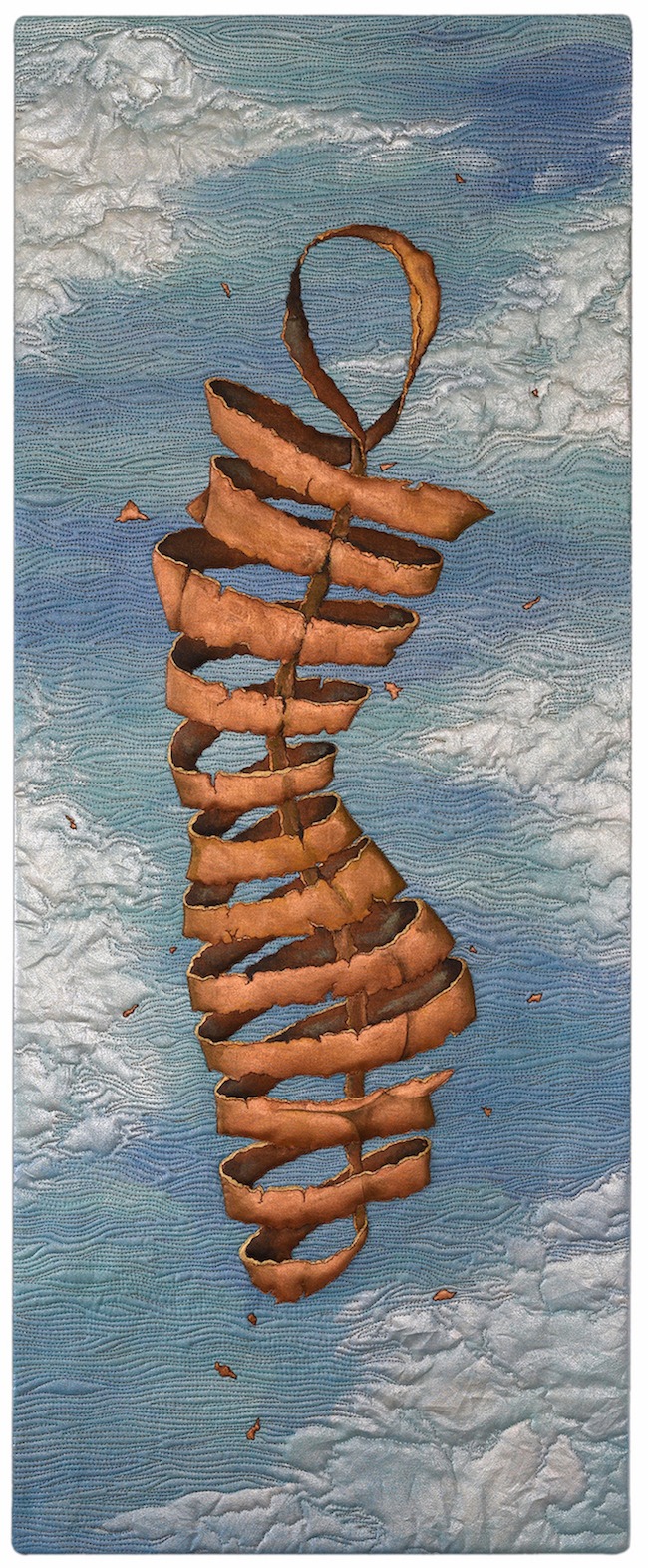
About the piece: We are all held mercilessly by the hands of time, our bodies dissolve or perhaps evolve depending on your point of view. Our souls to float the fourth dimension.
A human Mobius strip with no end and no beginning shows our unravelling, our ageing. Metallic to show our impervious nature as we fight back, doing all we can to delay the inevitable.
Do you give talks or run workshops or classes? If so where can readers find information about these?
I recently decided to limit my teaching to only a couple of times a year. I’m teaching in Melbourne in July this year for a local quilt guild.
Last year I was in Washington DC which was brilliant as I got to take some time to see the US and visit a couple of exhibitions my work was in at the same time.
I’d love to teach in the UK in the future sometime so if anyone is reading this and can make it happen (hint, hint).
I do occasional ‘how-to’ videos and tips on my Facebook art page and it’s something I’m going to be doing more of as soon as the studio is finished.
How do you go about choosing where to show your work?
I look for one of three things: Great exposure, renown museum or gallery venues or big prize money. I don’t get to create a lot of work so I have to be selective about where I show.
Where can readers see your work this year?
Around Australia and NZ as part of the AQC ‘Borders and Bridges’ themed challenge at the AQC and Craft & Quilt Fairs over 2018.
In Tasmania, Australia, as part of the ‘Ebb and Flow’ Tasmanian Quilter’s Guild juried exhibition, May 2nd–June 2nd, Maritime Museum of Tasmania, Hobart, Australia
In the Thread of Resistance exhibition at venues around the USA
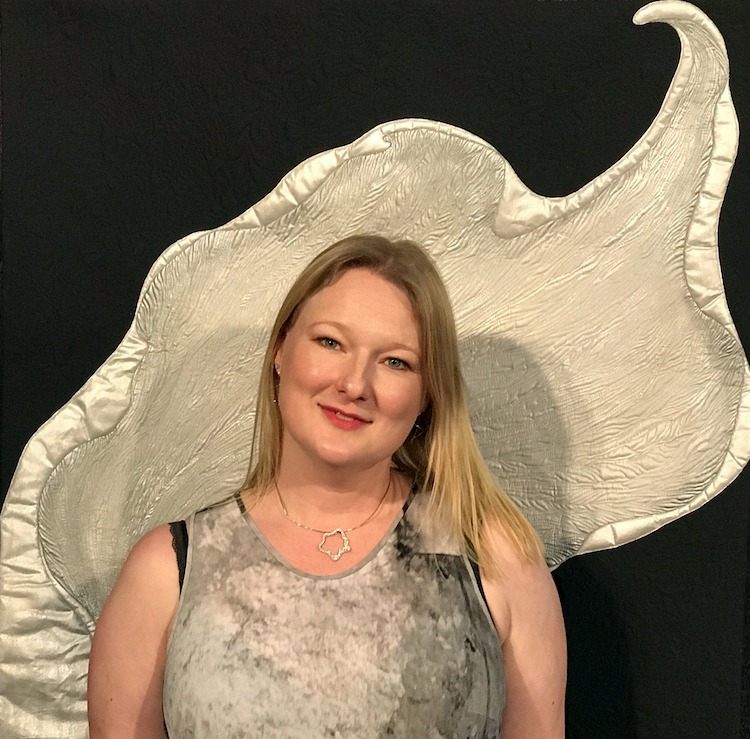
For more information visit: www.eiloren.com.au or find Neroli on Facebook
If you’ve enjoyed this interview why not share it with your friends on Facebook using the button below?
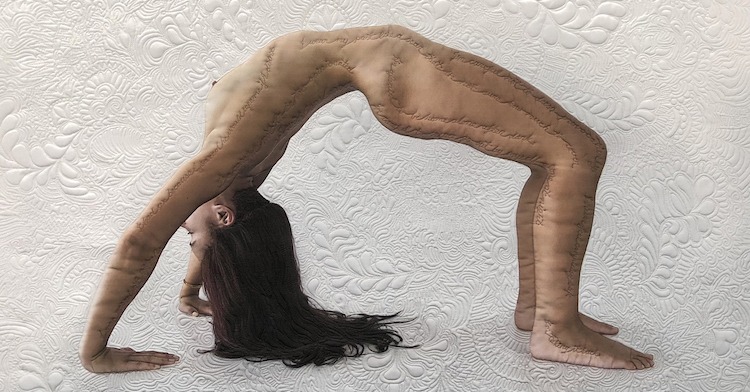
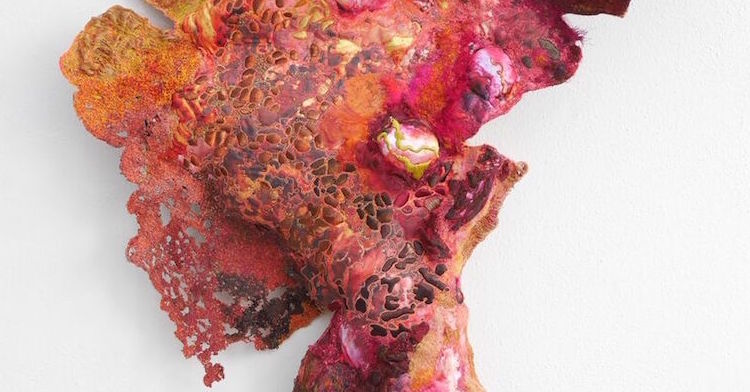
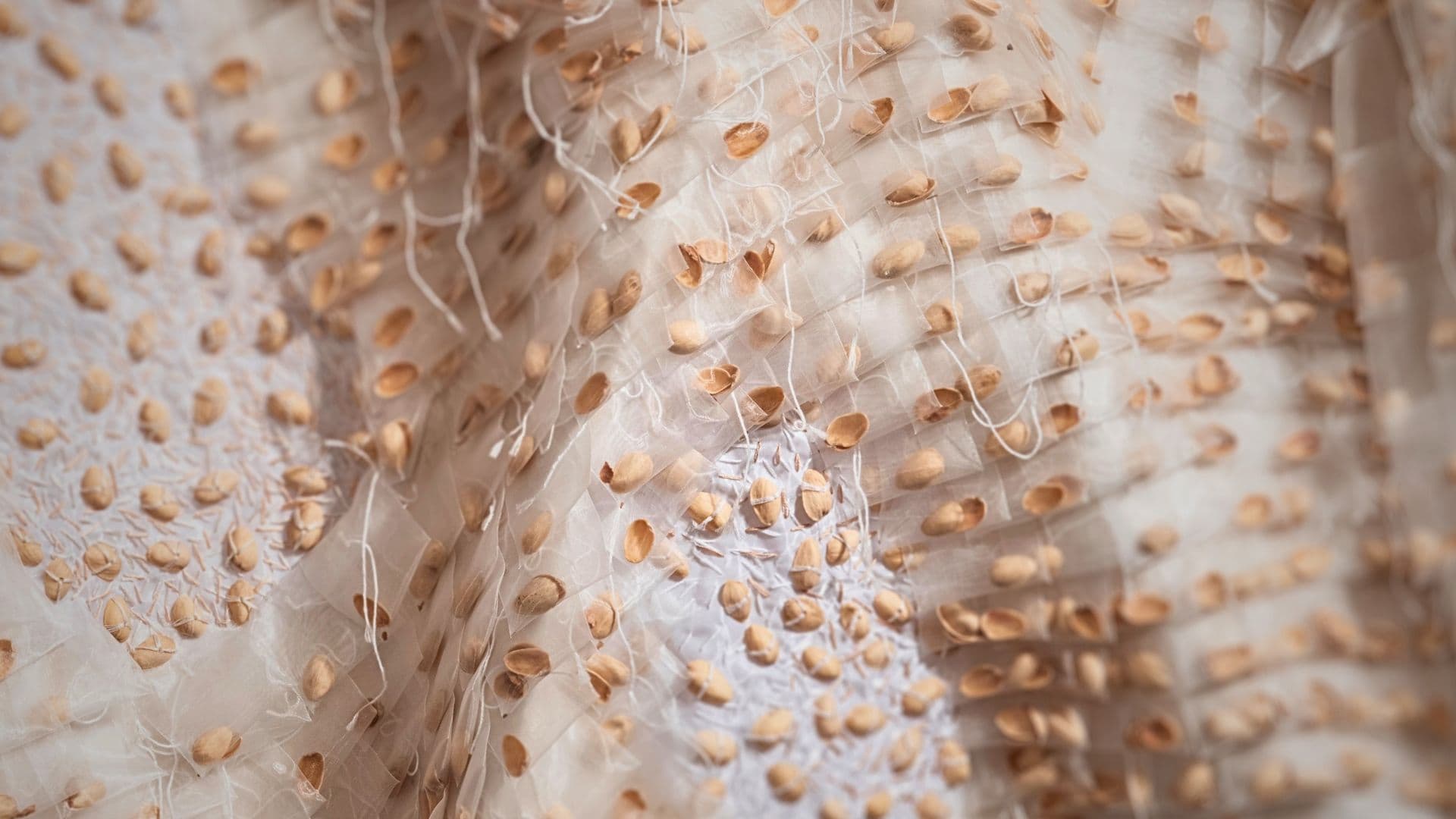
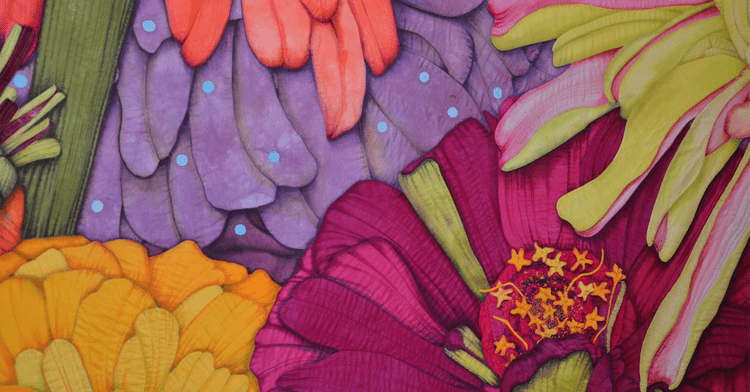
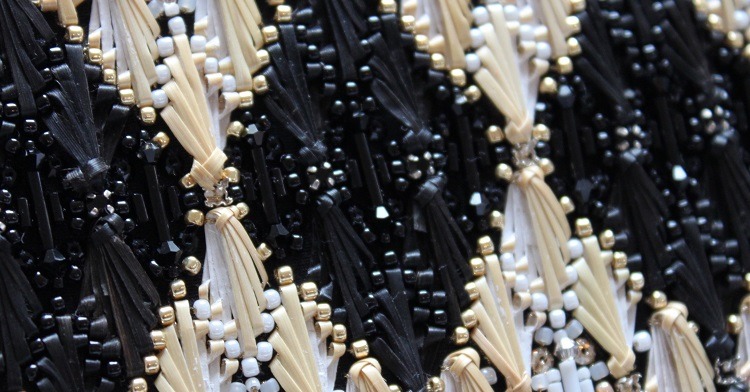
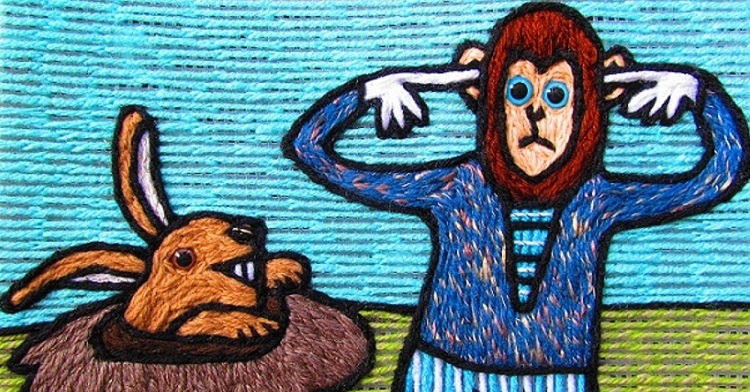
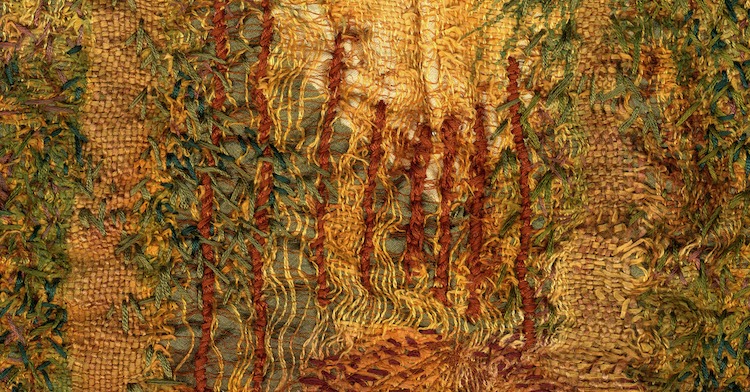
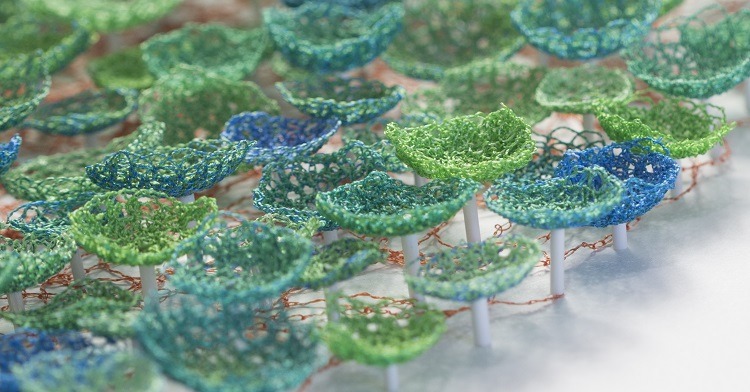
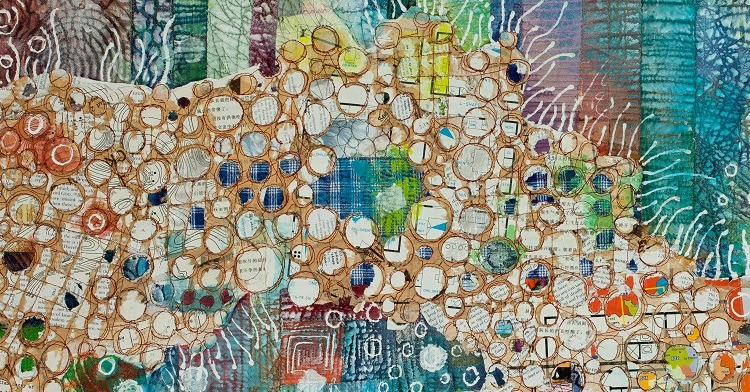
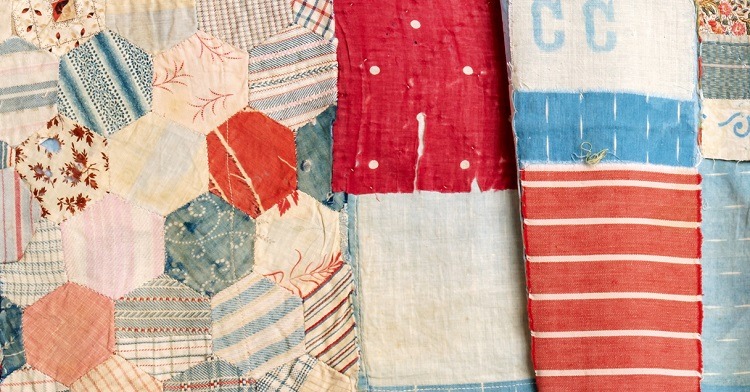
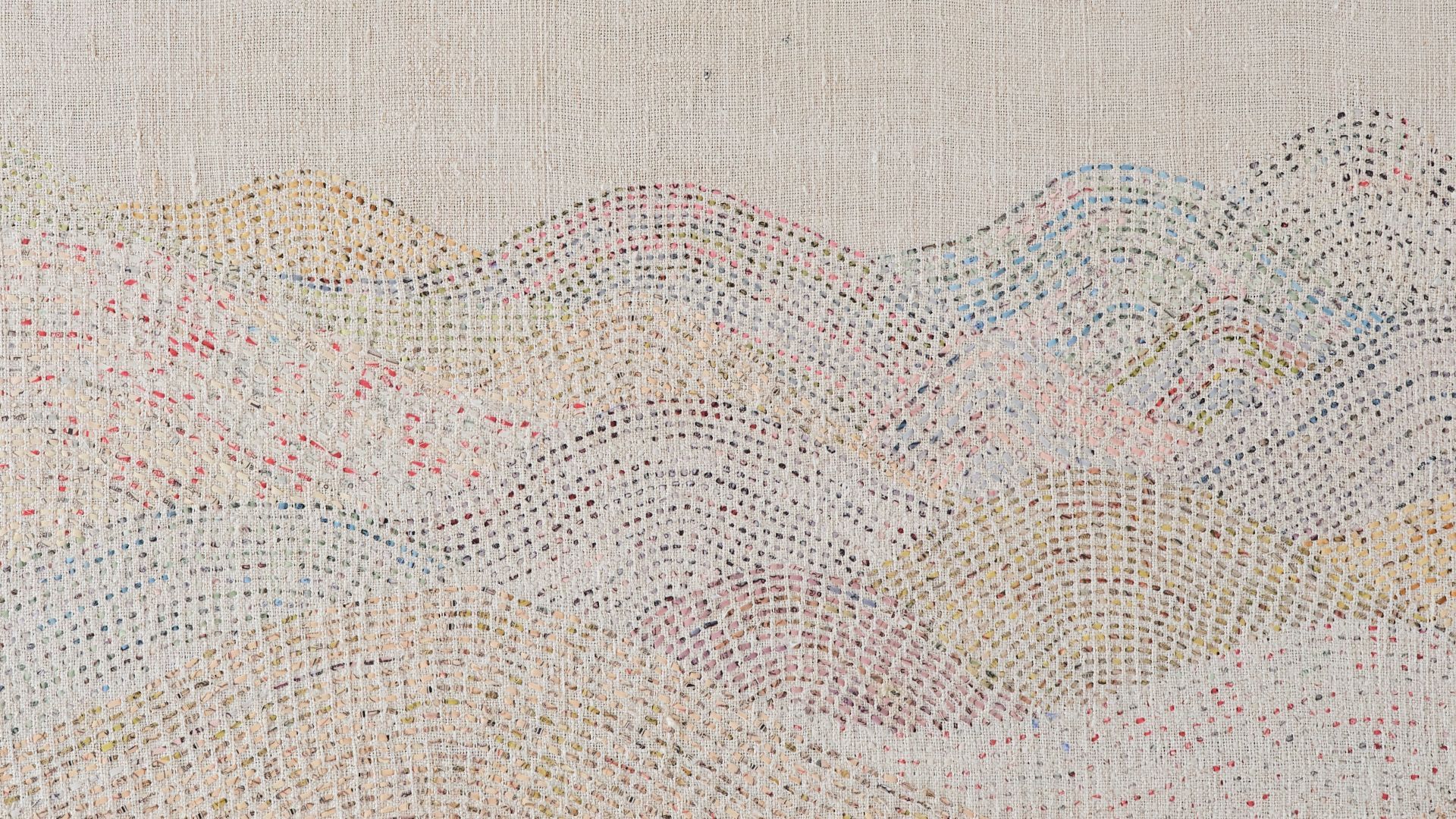
11 comments
Sarah Peck
Wow, what a great, interesting article. Your work is amazing and so meaningful Neroli. I love that each piece tells an important story as well as being beautifully quilted. Do you plan the free motion backgrounds or they just stitched intuitively?
Neroli
Hi Sarah, I’m so sorry, I’ve only just seen your question. I plan out the words, my sketch book will have a rough drawing of the pose before I take the photo often (to aid the model with direction), and then a huge amount of words and notes about the meaning etc will be on the page. While I’m sewing I go through the list and pull out the ones that speak to me loudest at the moment or that will work for that part of the quilt. Generally all of the stitching, other than that on the figures, it free drawn at the time of sewing, making it up with my needle. The only time I really plan is if there is a large directional line (like the spine of a feather) and then I will often put the work up on my design wall and crease in with my fingernail where that line is to be. I do regularly put my work up as I go through and reassess the directions I want my quilting to go in, butt the designs themselves are unplanned.
Sarah Ann Smith
What a wonderful interview, Neroli! Glad to learn more about you and see your art being recognized!
Lindy
What a fantastic piece on such a talented lady! I love the depth of feeling you put into every piece.
Neroli Henderson
Thanks so much Lindy, it means a lot.
Carol Naylor
Fabulous article by Neroli, who has become a good friend through the Textile Arts Facebook group. So pleased to see her getting the recognition she so richly deserves.
Neroli Henderson
Thank you Carol, and for all you do for the Textile Arts group (which for those who don’t know is tons!). Really appreciate everything you do.
leanne
thanks so much for this wonderful interview with a very talented Australian artist !
Neroli Henderson
Thank you Leanne! <3
Alice Abrash
Really great and inspiring article, and the art work is fabulous. I love that she embeds words into her work. Knowing that the words have been stitched (actually puncturing the fabric) makes their meaning so much stronger than they would be if simply printed on the surface. Thank you so much!
Neroli Henderson
Thanks so much Alice, that’s a great take on the text that I hadn’t considered before. Thank you!